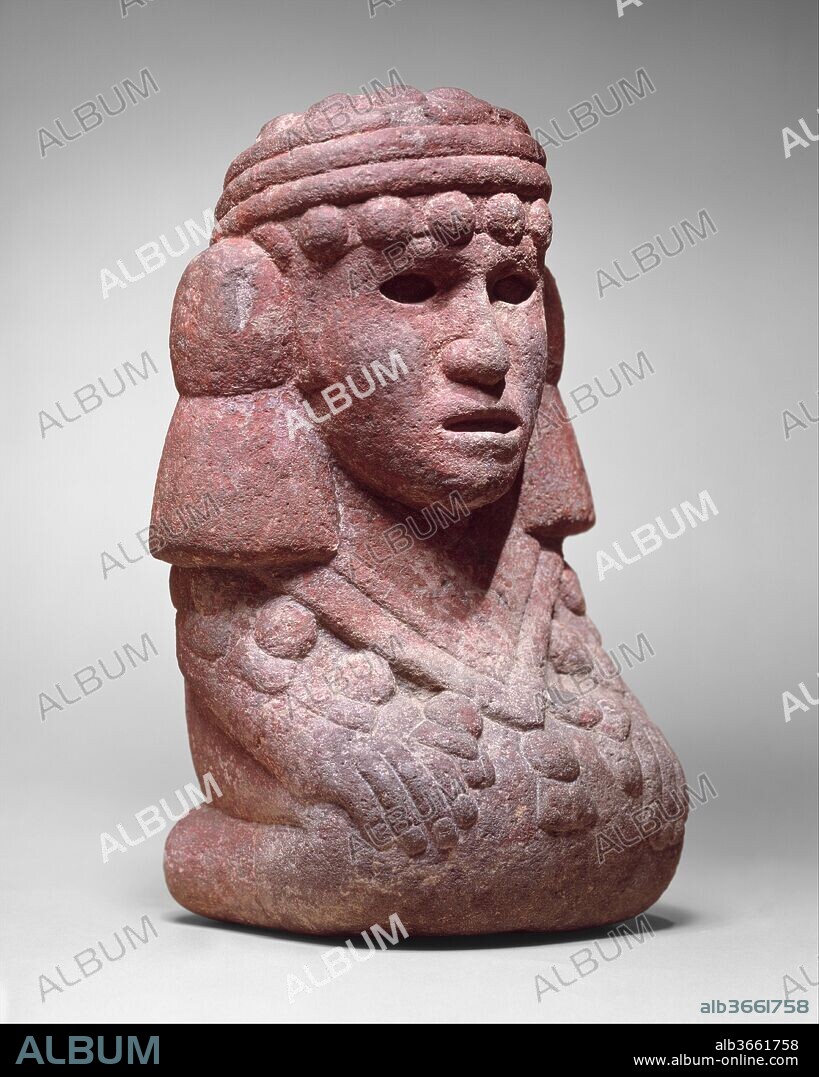alb3661758
Water Deity (Chalchiuhtlicue)

|
Añadir a otro lightbox |
|
Añadir a otro lightbox |



¿Ya tienes cuenta? Iniciar sesión
¿No tienes cuenta? Regístrate
Compra esta imagen.
Selecciona el uso:

Título:
Water Deity (Chalchiuhtlicue)
Descripción:
Traducción automática: Deidad del agua (Chalchiuhtlicue). Cultura: Azteca. Dimensiones: H. 11 5/8 × W. 7 1/8 × D. 5 1/2 pulg. (29,5 × 18,1 × 14 cm). Fecha: XV-principios del siglo XVI. La figura finamente tallada pertenece a un grupo considerable de mujeres arrodilladas que exhiben elementos de vestuario que las identifican como deidades del agua llamadas Chalchiuhtlicue ("la de la falda de jade") en náhuatl, el idioma hablado por los aztecas. En la religión azteca, la diosa del agua era la esposa del dios de la lluvia Tláloc, una antigua deidad que había sido adorada durante mucho tiempo en toda Mesoamérica. Chalchiuhtlicue simbolizaba la pureza y el valor del agua de manantial, río y lago que se utilizaba para irrigar los campos. Como diosa de la fertilidad, retrata el ideal azteca de la feminidad joven y fértil. Lo más típico del disfraz de diosa del agua es el tocado distintivo que consiste en múltiples bandas gruesas, probablemente de algodón, enrolladas alrededor de la cabeza y bordeadas arriba y abajo por hileras de bolas y dos grandes borlas unidas a los lados de la cabeza. En la espalda, las bandas están retorcidas y atadas en un nudo prominente, y los extremos con borlas caen sobre su cabello liso. Su vestimenta es la de una mujer noble con falda y capa triangular bordeada por un fleco de borlas. La diosa del agua estaba estrechamente relacionada con la diosa azteca del maíz, Chicomecoatl, a quien a menudo también se la muestra usando este tocado, mientras sostiene mazorcas de maíz en sus manos.
Water Deity (Chalchiuhtlicue). Culture: Aztec. Dimensions: H. 11 5/8 × W. 7 1/8 × D. 5 1/2 in. (29.5 × 18.1 × 14 cm). Date: 15th-early 16th century.
The finely carved figure belongs to a sizable group of kneeling females that display costume elements identifying them as water deities called Chalchiuhtlicue ("she of the jade skirt") in Nahuatl, the language spoken by the Aztecs. In Aztec religion, the water goddess was the wife of the rain god Tlaloc, an ancient deity that had long been worshipped throughout Mesoamerica. Chalchiuhtlicue symbolized the purity and preciousness of spring, river, and lake water that was used to irrigate the fields. As a fertility goddess, she portrays the Aztec ideal of fertile young womanhood. Most typical of the water goddess costume is the distinctive headdress consisting of multiple thick bands, probably cotton, wound about the head and bordered above and below by rows of balls and two large tassels attached to the sides of the head. In back, the bands are twisted and tied in a prominent knot, the tasseled ends falling over her straight hair. Her clothing is that of a noble woman with a skirt and triangular shoulder cape bordered by a tasseled fringe. The water goddess was closely related to the Aztec corn goddess, Chicomecoatl, who is often also shown wearing this headdress, while holding ears of corn in her hands.
Técnica/material:
Basalt, pigment
Museo:
Metropolitan Museum of Art, New York, USA
Crédito:
Album / Metropolitan Museum of Art, NY
Autorizaciones:
Modelo: No - Propiedad: No
¿Preguntas relacionadas con los derechos?
¿Preguntas relacionadas con los derechos?
Tamaño imagen:
3276 x 4094 px | 38.4 MB
Tamaño impresión:
27.7 x 34.7 cm | 10.9 x 13.6 in (300 dpi)
Palabras clave:
 Pinterest
Pinterest Twitter
Twitter Facebook
Facebook Copiar enlace
Copiar enlace Email
Email
